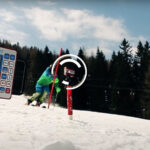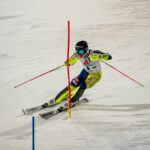I have a lot of pet peeves when it comes to ski racers when they’re training including leaning on their poles shortly before a training run (no intensity), chatting it up with teammates when they’re in the starting gate of a training course (no focus), and half-hearted effort to the first gate (easing into the course means leaving time on the hill). But I now have added a new pet peeve that has quickly risen to the top of my list, namely, racers having their phones with them and checking their social media between runs.
 This pet peeve extends far beyond the hill and into the daily lives of young people. The last generation or two (those who grew up after the iPhone was invented) have become addicted to social media including Facebook, Twitter, Instagram, TikTok, Snapchat, and texting. When I use the word “addicted”, I mean literally so; research has demonstrated that social media has the same neurochemical effect on the brain as drugs, alcohol, and gambling.
This pet peeve extends far beyond the hill and into the daily lives of young people. The last generation or two (those who grew up after the iPhone was invented) have become addicted to social media including Facebook, Twitter, Instagram, TikTok, Snapchat, and texting. When I use the word “addicted”, I mean literally so; research has demonstrated that social media has the same neurochemical effect on the brain as drugs, alcohol, and gambling.
A broader discussion of the role of technology in human development is beyond the scope of this article (but you can read more about it on my Technology blog), but there are some real implications of media overuse and misuse on the lives and development of ski racers and that is what I’m going to explore in this article.
Let’s return to my newest pet peeve, namely, the apparent inability of most young racers to disconnect from their phones, even during training. So, you may wonder, how is this incessant use of media impacting ski racers?
The biggest area in which racers are finding more and more difficulty is in the simple act of focusing. Considerable research has found that the attention spans of young people have decreased since the rise of smartphones and social media. Because of the distractions caused by the constant pinging, buzzing, and vibrating of social media notifications, young people are losing the ability to stay focused for extended periods. The result has been a decline in study habits, learning, and grades.
the attention spans of young people have decreased since the rise of smartphones and social media. Because of the distractions caused by the constant pinging, buzzing, and vibrating of social media notifications, young people are losing the ability to stay focused for extended periods. The result has been a decline in study habits, learning, and grades.
This problem is no less evident and no less of a problem in ski racing. Many coaches in recent years have told me that their racers are far less able to focus compared to previous generations of racers. The consensus is that racers in general these days are less able to pay attention to their coaches’ instructions, remember the feedback, and stay focused from start to finish in training and races.
One of the most common reasons young racers come to me is because they say they have trouble focusing on what they’re working on in  training and they make mistakes in races because they lose focus. And in recent years, I have also found that young racers have a much more difficult time staying focus during imagery sessions I conduct with them. Many tell me that their minds drift off quickly and they’re not able to maintain or regain their focus on their ski racing imagery easily.
training and they make mistakes in races because they lose focus. And in recent years, I have also found that young racers have a much more difficult time staying focus during imagery sessions I conduct with them. Many tell me that their minds drift off quickly and they’re not able to maintain or regain their focus on their ski racing imagery easily.
Why is focus so important in ski racing? Well, the ability to focus is the foundation of so many things related to consistently fast skiing. Focus impacts learning and skill acquisition. Without the capacity for sustained focus, racers will forget what they are working on technically or tactically during training. As soon as racers lose focus, they stop doing whatever they were working on and return to and further ingrain old and bad skills and habits. Without an ability to maintain focus for longer periods of time (say, 45-90 seconds of race courses, they won’t be able to gain enough quality repetition necessary to effectively ingrain new ski-racing technique and tactics. The bottom line is that racers won’t develop as fully or as quickly as they are capable of and, as a result, may never realization their fullest abilities.
Focus plays a big role on race day as well. First, focus is important during inspection. Your ability to focus influences your memory of the course as you inspect. If you can’t focus well as you are slipping the course, you won’t transfer your inspection of the course to long-term memory. And we all know that terrible feeling of reviewing the course in your mind in the start area before your race run and saying, “OMG! Is that a flush or a hairpin after the transition?”
Focus is important on course as well. Without consistent focus from start to finish, whether on technique, tactics, or just going fast, racers have little chance to ski a race course without mistakes. And if the mistakes due to lack of focus are big enough, it will result in a bi g, fat DNF!
g, fat DNF!
Now, I can’t realistically get racers to set limits on media use away from our sport. At the same time, I would like to make some reasonable suggestions that racers, coaches, and programs can implement to at least keep the tech monster at bay while racers are training and racing.
First, a few thoughts for racers. Off the hill, a consistent program of mental imagery is one of the best antidotes to the loss of focus due to excessive media use. When you do imagery, you are, by its very nature, requiring yourself to focus, thereby exercising your focus muscle and training it to focus from the start to the finish of your imagined runs.
On snow, I do understand that many of you (including most World Cuppers) use your smartphone as a mental tool on race day, mainly by listening to music to help you get motivated, establish a positive mindset, adjust your intensity, keep your mind off the race, and generate positive emotions. I totally support that!
But when it comes to training, do you really need to listen to music on the ride up the lift? Do you really need to be checking your social media between runs? I would encourage you to ask yourself what will and will not help you to stay focused in training and consider leaving your phone in your boot bag when you head out for training.
Second, for coaches. You should have a conversation with your athletes in which you educate them about the importance of focus and talk to them about how media during training and races can help or hurt their preparations and skiing. See if you can come to some consensus on how, when, and where they use their media that will actually help them to ski their fastest.
Third, for programs. At the club, team, or academy level, I would recommend that you assemble a committee of coaches, parents, and racers to create some guidelines that can help shape the culture of media use in your program. These guidelines will act as the norms and defaults for media use, so racers will be more likely to adhere to them. For example, some common-sense recommendations could include:
- No phones on the hill during training,
- No phones at team meetings,
- For academies, no phones at meals (they discourage face-to-face social interactions),
- Race-day use limited to music.
As we all know, ski racing is a sport of milliseconds. Any advantage you can gain that will enable you to ski just a little bit faster can make a big difference on the result sheet at the end of the race day. One simple, yet powerful, advantage you can gain is to be able to focus effectively in training and to be totally focused from start to finish in races. A key tool you can use to improve your focus is, in my humble opinion, to keep your phone off the hill in training and use it only as a tool, rather than a toy, on race day.






